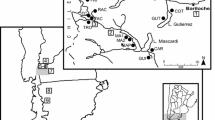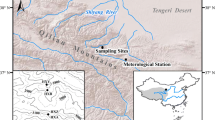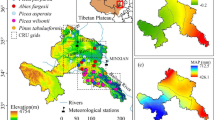Abstract
Key message
Both temperature and precipitation are strong factors of radial tree growth at all elevations in the semi-arid study area, except at the upper treeline where temperature becomes the major controlling factor.
Abstract
Several recent studies across the Tibetan Plateau found consistent growth–climate relations at all elevations from the lower treelines to the upper treelines. These findings seem to challenge the general principle of dendroclimatology that precipitation serves as the controlling factor of radial tree growth at lower elevations while temperature serves as the controlling factor at higher elevations in semi-arid regions. Such conclusions also question the potential of temperature reconstruction using ring-width data in these regions if precipitation remains the dominant factor of tree growth at the upper treelines. In this study, radial growth of Qilian juniper (Sabina przewalskii Kom.) was examined along an elevation gradient between ~3820 and 4230 m in the mountains east of the Qaidam Basin, northeastern Tibetan Plateau, to determine the limiting factors of radial tree growth at different elevations. Rotated principal component analysis revealed two modes of variation patterns. The first mode presents mostly tree ring data from the lower elevation zones (3820–4100 m) and contains strong signals of precipitation variation. The second mode represents the higher elevation zones (approx. 4100–4230 m) and contains strong signals of both temperature and precipitation variations. When signals of precipitation variation are removed from the tree ring data using partial correlation, the growth–temperature relationships become more evident on the upper slope. When correlations between individual tree-ring series and climate variables were examined, we discovered that there were better chances of finding tree ring samples strongly correlated to temperature variables (r = 0.6 or higher) at the elevation zone within ~100 m of the upper treeline, but uncommon at lower elevations. We also found that topographic variables, such as slope gradient and growing-season direct solar radiation may have minor influences on the growth–climate relationships.








Similar content being viewed by others
References
Berdanier AB (2010) Global treeline position. Nat Educ Knowl 3:11
Briffa KR, Osborn TJ, Schweingruber FH (2004) Large-scale temperature inferences from tree rings: a review. Global Planet Change 40:11–26
Cook ER, Kairiukstis LA (1990) Methods of dendrochronology: applications in the environmental sciences. Kluwer, Dordrecht, pp 1–394
Cook ER, Seager R, Cane MA, Stahle DW (2007) North American drought: reconstructions, causes, and consequences. Earth Sci Rev 81:93–134
Cook ER, Anchukaitis KJ, Buckley BM, D’Arrigo RD, Jacoby GC, Wright WE (2010) Asian monsoon failure and megadrought during the last millennium. Science 328:486–489
Esper J, Frank DC, Wilson RJS, Buntgen U, Treydte K (2007) Uniform growth trends among central Asian low- and high-elevation juniper tree sites. Trees Struct Funct 21:141–150
Fritts HC (1976) Tree rings and climate. Academic Press, London
Gao LL, Gou XH, Deng Y, Liu WH, Yang MX, Zhao ZQ (2013) Climate–growth analysis of Qilian juniper across an altitudinal gradient in the central Qilian Mountains, northwest China. Trees Struct Funct 27:379–388
Graumlich LJ (1991) Sub-alpine tree growth, climate, and increasing CO2-an assessment of recent growth trends. Ecology 72:1–11
Graumlich LJ (1993) A 1000-year record of temperature and precipitation in the Sierra-Nevada. Quat Res 39:249–255
He MH, Yang B, Brauning A (2013) Tree growth–climate relationships of Juniperus tibetica along an altitudinal gradient on the southern Tibetan Plateau. Trees Struct Funct 27:429–439
Holmes RL (1983) Computer-assisted quality control in tree-ring dating and measurement. Tree Ring Bull 43:69–78
Körner C (1998) A re-assessment of high elevation treeline positions and their explanation. Oecologia 115:445–459
Körner C (2012) Alpine treelines—functional ecology of the global high elevation tree limits. Springer, Basel 220
Lang HR, Welch R (1999) Algorithm theoretical basis document for ASTER digital elevation models (ATBD-AST-08). Jet Propulsion Laboratory, Pasadena 63
Liang EY, Shao XM, Eckstein D, Huang L, Liu XH (2006) Topography- and species-dependent growth responses of Sabina przewalskii and Picea crassifolia to climate on the northeast Tibetan Plateau. Forest Ecol Manag 236:268–277
Liu LS, Shao XM, Liang EY (2006) Climate signals from tree ring chronologies of the upper and lower treelines in the Dulan region of the Northeastern Qinghai-Tibetan Plateau. J Integr Plant Biol 48:278–285
Liu Y, An Z, Linderholm HW, Chen D, Song H, Cai Q, Sun J, Tian H (2009) Annual temperatures during the last 2485 years in the mid-eastern Tibetan Plateau inferred from tree rings. Sci China Earth Sci 52:348–359
Mann ME, Zhang Z, Hughes MK, Bradley RS, Miller SK, Rutherford S, Ni F (2008) Proxy-based reconstructions of hemispheric and global surface temperature variations over the past two millennia. Proc Natl Acad Sci USA 105:13252–13257
Neukom R, Gergis J (2012) Southern hemisphere high-resolution palaeoclimate records of the last 2000 years. Holocene 22:501–524
Peng JF, Gou XH, Chen FH, Li JB, Liu PX, Zhang Y, Fang KY (2008) Difference in tree growth responses to climate at the upper treeline: Qilian Juniper in the Anyemaqen Mountains. J Integr Plant Biol 50:982–990
Qin C, Yang B, Melvin TM, Fan ZX, Zhao Y, Briffa KR (2013) Radial growth of Qilian Juniper on the northeast Tibetan Plateau and potential climate associations. PLoS One 8:15
Richman MB (1986) Rotation of principal components. J Climatol 6:293–335
Shao XM, Huang L, Liu HB, Liang EY, Fang XQ, Wang LL (2005) Reconstruction of precipitation variation from tree rings in recent 1000 years in Delingha, Qinghai. Sci China Earth Sci 48:939–949
Shao X, Xu Y, Yin ZY, Liang E, Zhu H, Wang S (2010) Climatic implications of a 3585-year tree-ring width chronology from the northeastern Qinghai-Tibetan Plateau. Quat Sci Rev 29:2111–2122
Sheppard PR (2010) Dendroclimatology: extracting climate from trees. Wires Clim Change 1:343–352
Sheppard PR, Tarasov PE, Graumlich LJ, Heussner KU, Wagner M, Österle H, Thompson LG (2004) Annual precipitation since 515 BC reconstructed from living and fossil juniper growth of northeastern Qinghai Province, China. Clim Dyn 23:869–881
Stokes MA, Smiley TL (1968) An introduction to tree-ring dating. University of Chicago Press, Chicago
Wang Z, Yang B, Deslauriers A, Bräuning A (2015) Intra-annual stem radial increment response of Qilian juniper to temperature and precipitation along an altitudinal gradient in northwestern China. Trees Struct Funct 29:25–34
White D, Richman M, Yarnal B (1991) Climate regionalization and rotation of principal components. Int J Climatol 11:1–25
Wing MG, Eklund A, Kellogg LD (2005) Consumer-grade global positioning system (GPS) accuracy and reliability. J Forest 103:169–173
Yang B, He MH, Melvin TM, Zhao Y, Briffa KR (2013) Climate control on tree growth at the upper and lower treelines: a case study in the Qilian Mountains, Tibetan Plateau. PLoS One 8. doi:10.1371/journal.pone.0069065
Yin ZY, Shao XM, Qin NS, Liang E (2008) Reconstruction of a 1436-year soil moisture and vegetation water use history based on tree-ring widths from Qilian junipers in northeastern Qaidam Basin, northwestern China. Int J Climatol 28:37–53
Zhang QB, Cheng GD, Yao TD, Kang XC, Huang JG (2003) A 2,326-year tree-ring record of climate variability on the northeastern Qinghai-Tibetan Plateau. Geophy Res Lett 30
Zhang Y, Shao XM, Yin ZY, Wang Y (2014) Millennial minimum temperature variations in the Qilian Mountains, China: evidence from tree rings. Clim Past 10:1763–1778
Zheng YH, Zhu HF, Zhang YX, Shao XM (2009) Relationship between Sabina przewalskii radial growth and climatic factors at upper timber-lines in eastern mountainous region of Qaidam Basin. Chin J Appl Ecol 20:507–512
Zhu HF, Zheng YH, Shao XM, Liu XH, Xu Y, Liang EY (2008) Millennial temperature reconstruction based on tree-ring widths of Qilian juniper from Wulan, Qinghai Province, China. Chin Sci Bull 53:3914–3920
Acknowledgments
The authors thank Dr. Hui Zhang, PhD. student Yang Wang and Feng Chen from the Institute of Geographic Sciences and Natural Resources Research, Chinese Academy of Sciences, for participation in collecting samples. This study was in part supported by grants from the CAS Strategic Priority Research Program (Grant No. XDA05080201), the China Natural Science Foundation (Grant No. 41471170), and University of San Diego (FRG# 2014–2015 and 2015–2016). The authors thank China Meteorological Administration (CMA) for providing climatic data used in this study, US Geological Survey and NASA for providing the ASTER GDEM v2 data, and two anonymous reviewers for their constructive comments and suggestions that helped improve the manuscript substantially.
Author information
Authors and Affiliations
Corresponding author
Ethics declarations
Conflict of interest
The authors declare that they have no conflict of interest.
Additional information
Communicated by G. Wieser.
Electronic supplementary material
Below is the link to the electronic supplementary material.
Rights and permissions
About this article
Cite this article
Yin, ZY., Li, M., Zhang, Y. et al. Growth–climate relationships along an elevation gradient on a southeast-facing mountain slope in the semi-arid eastern Qaidam Basin, northeastern Tibetan Plateau. Trees 30, 1095–1109 (2016). https://doi.org/10.1007/s00468-015-1348-3
Received:
Revised:
Accepted:
Published:
Issue Date:
DOI: https://doi.org/10.1007/s00468-015-1348-3




